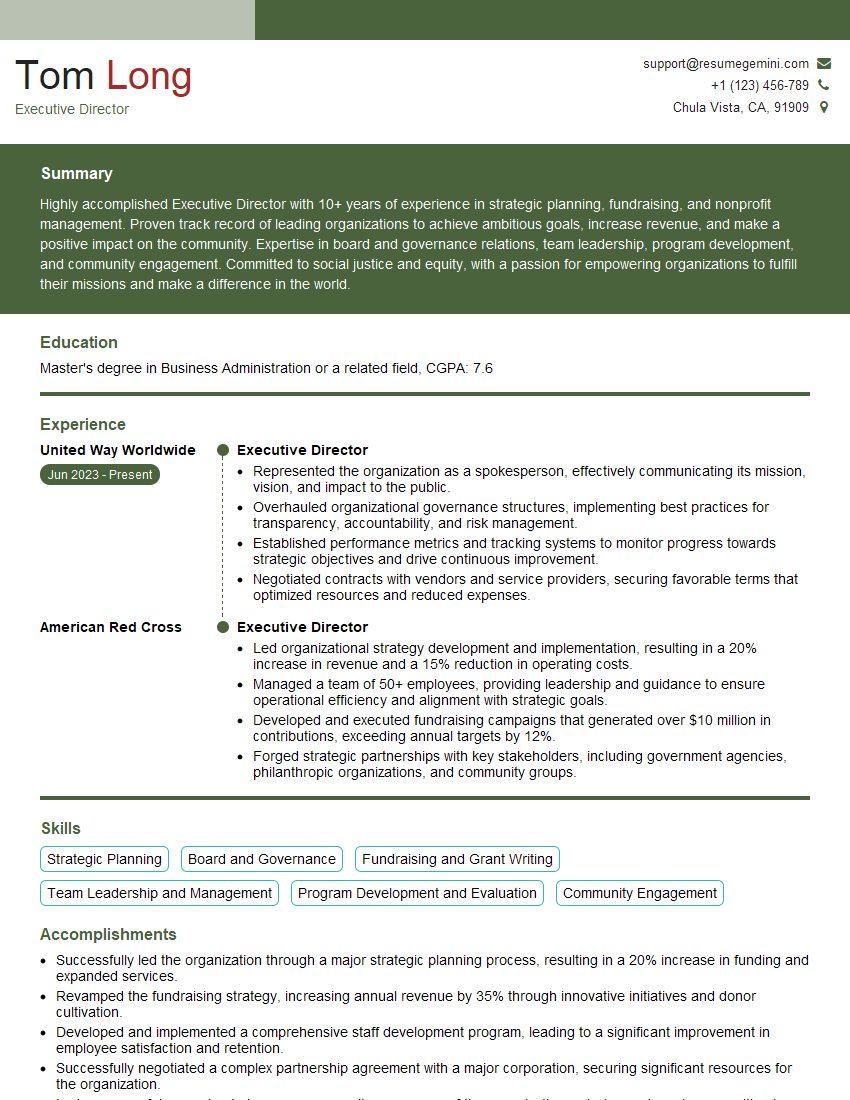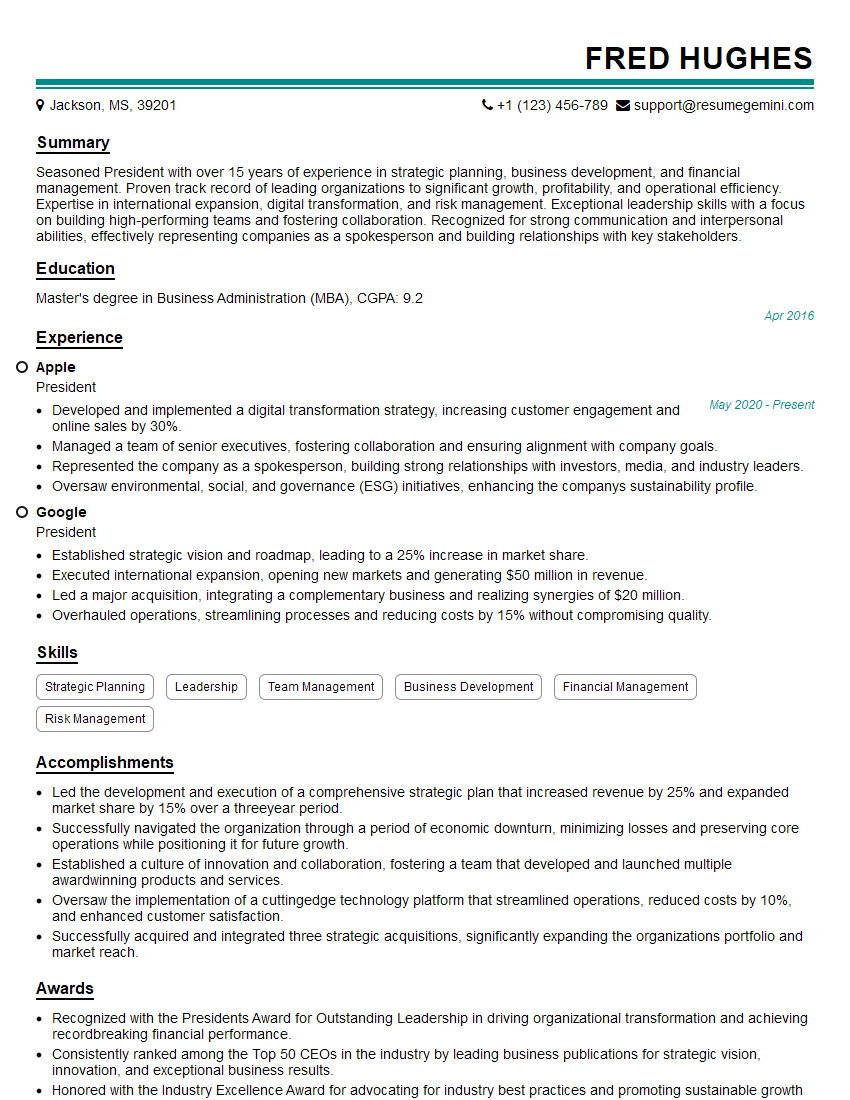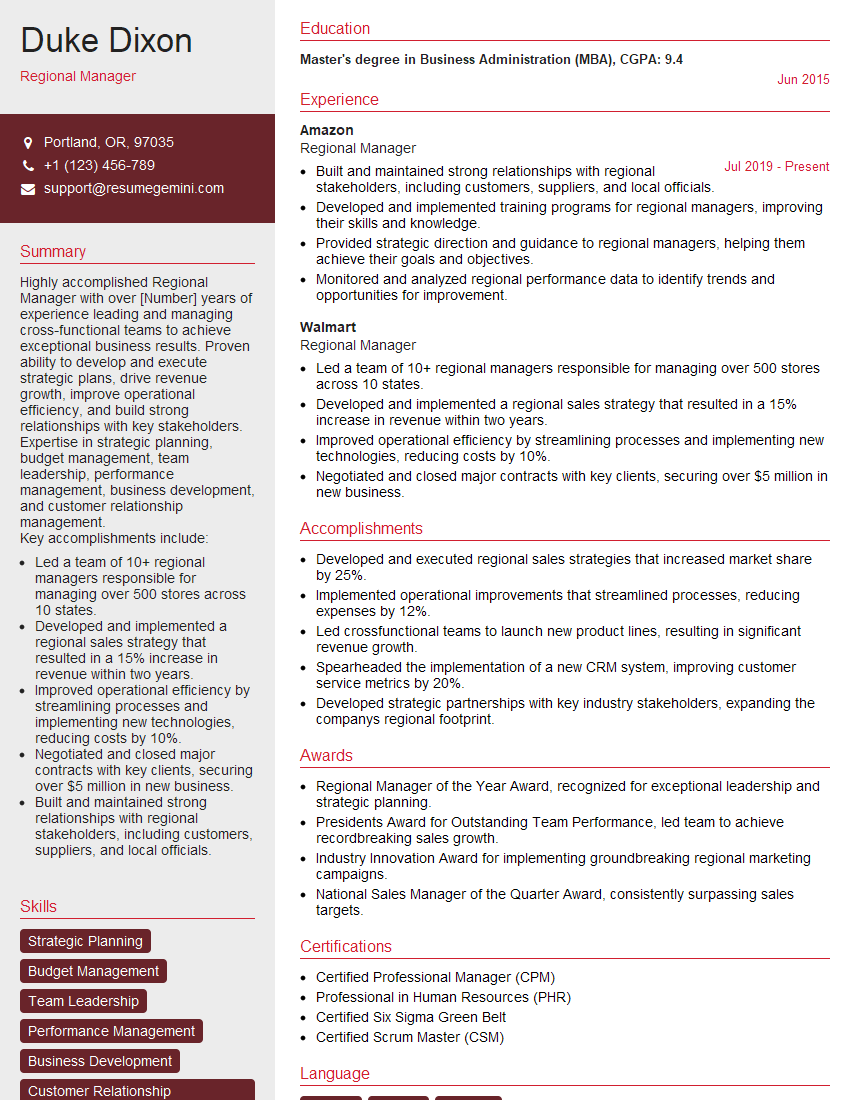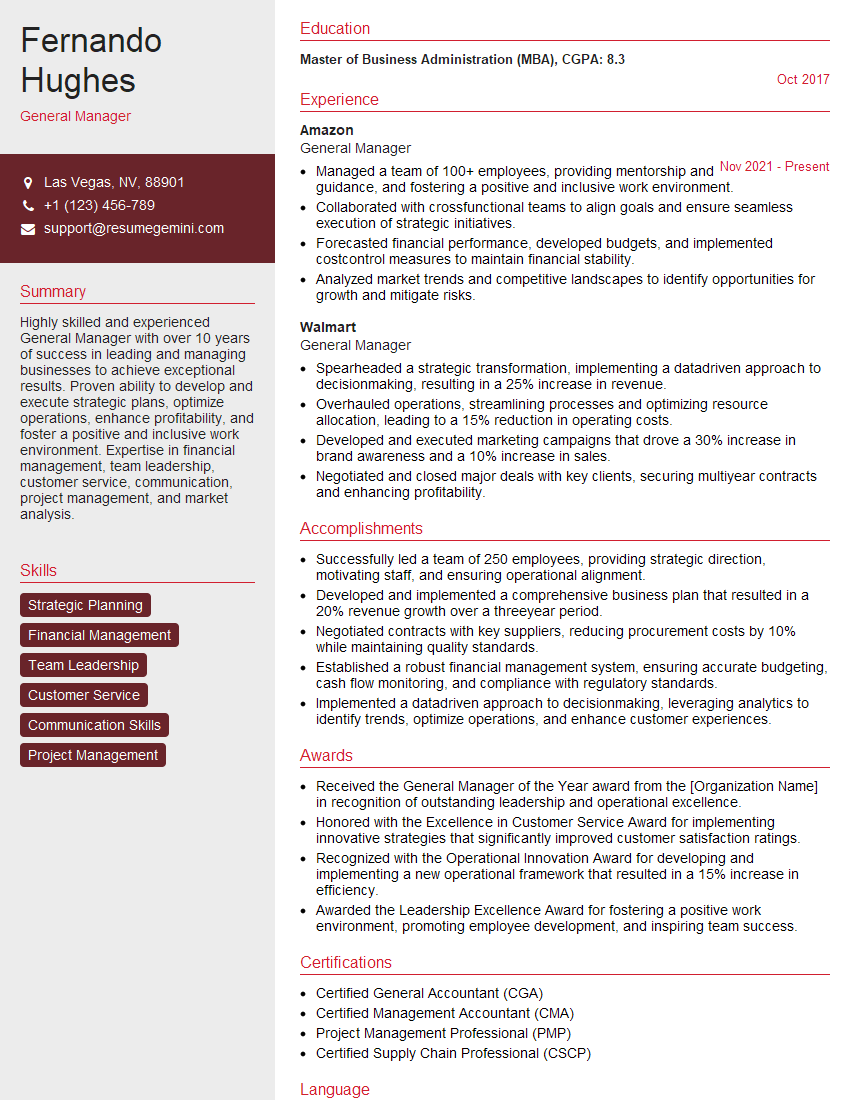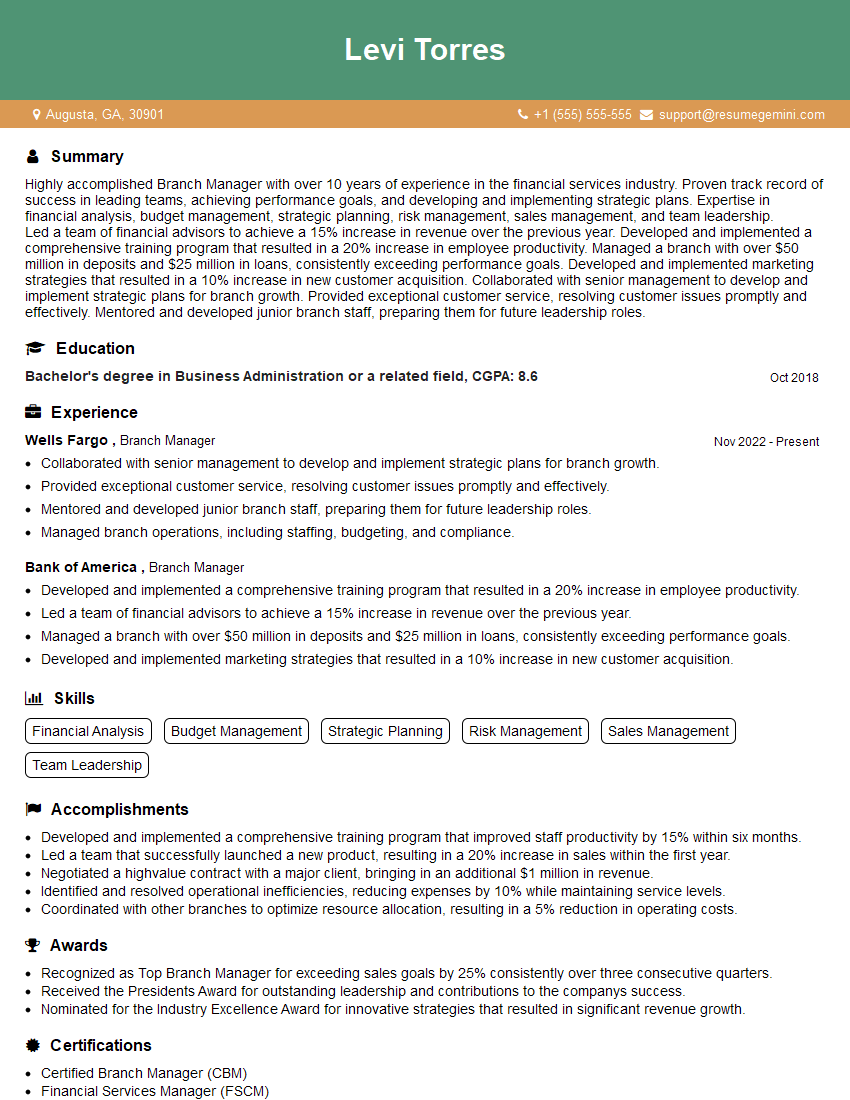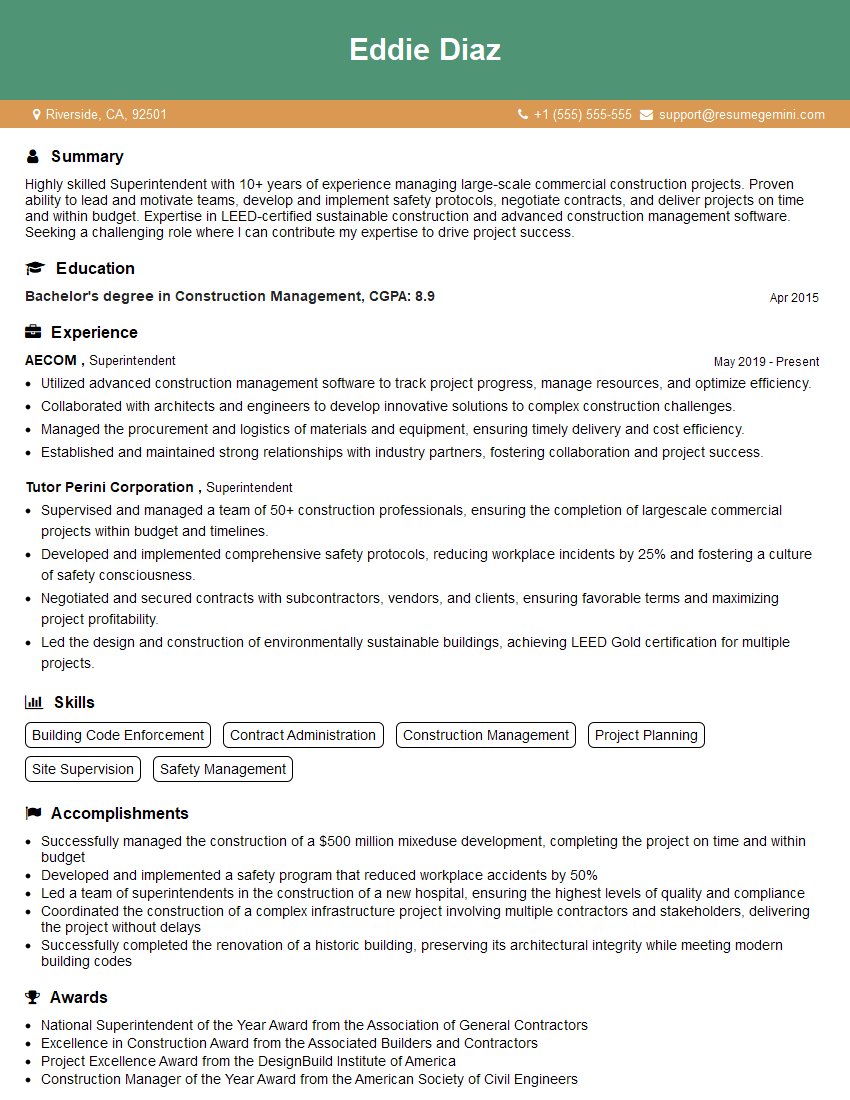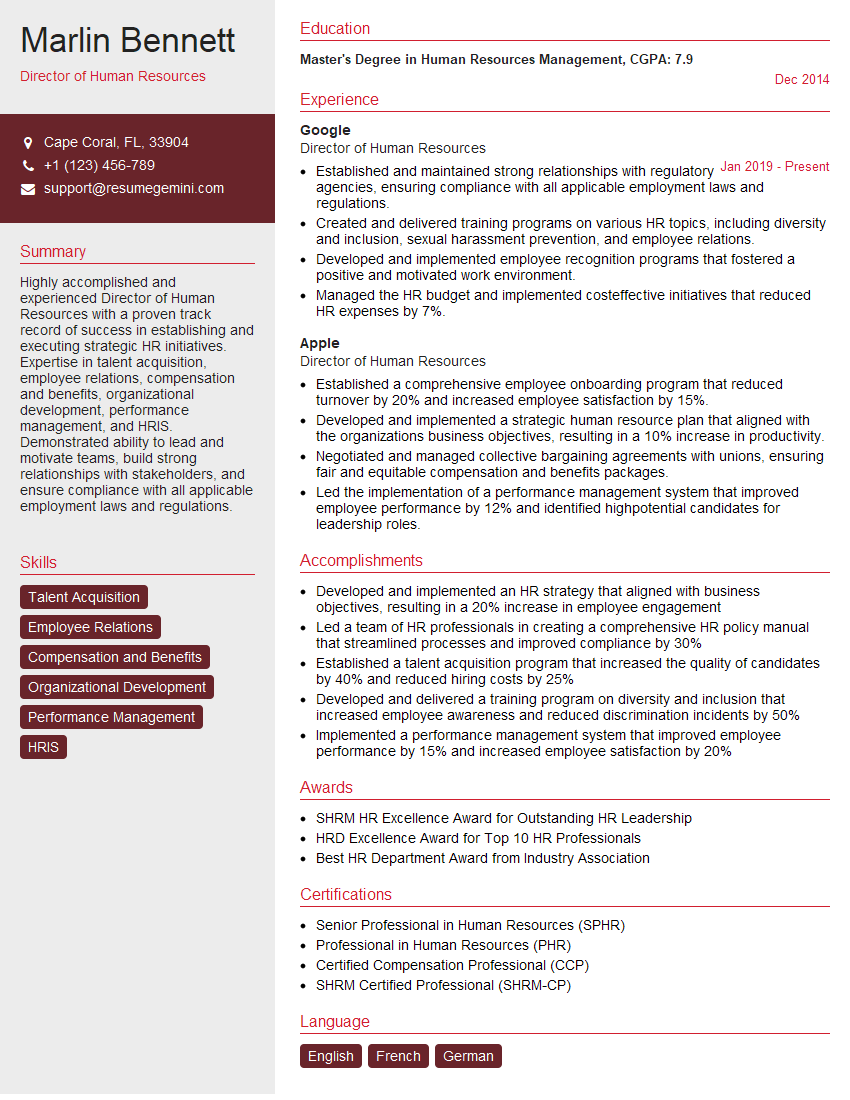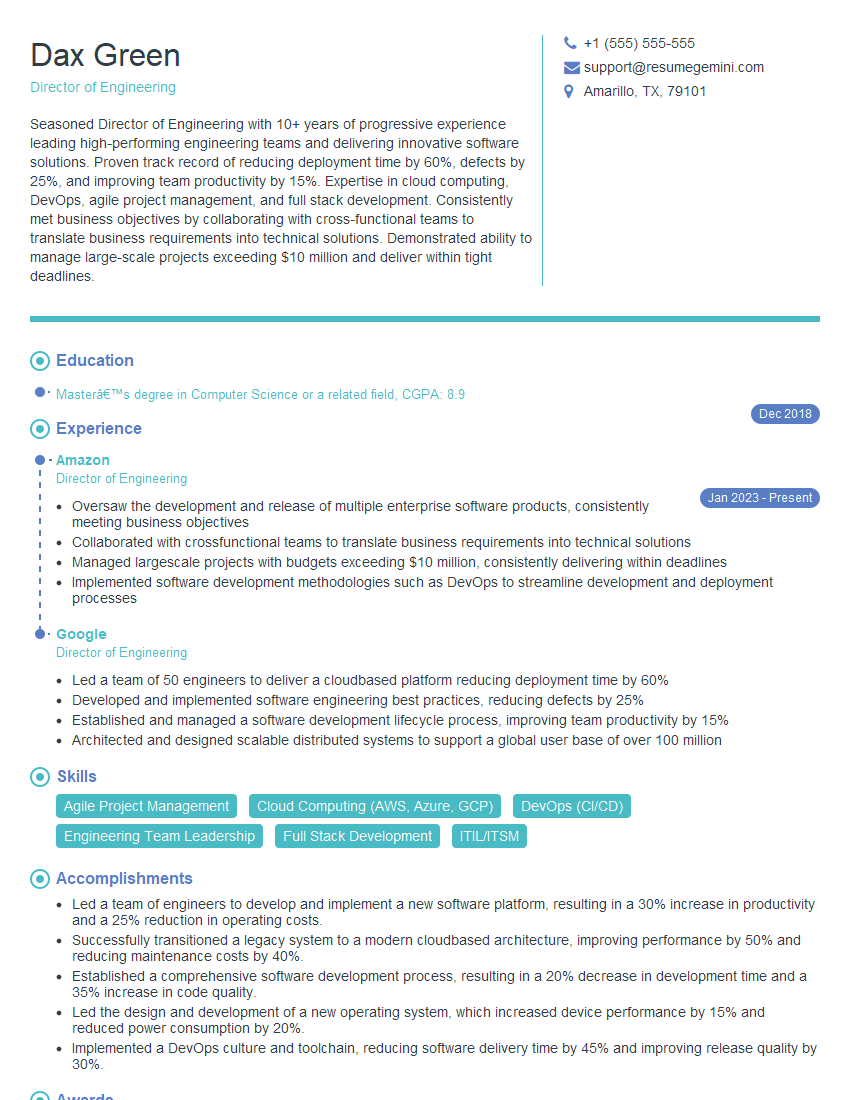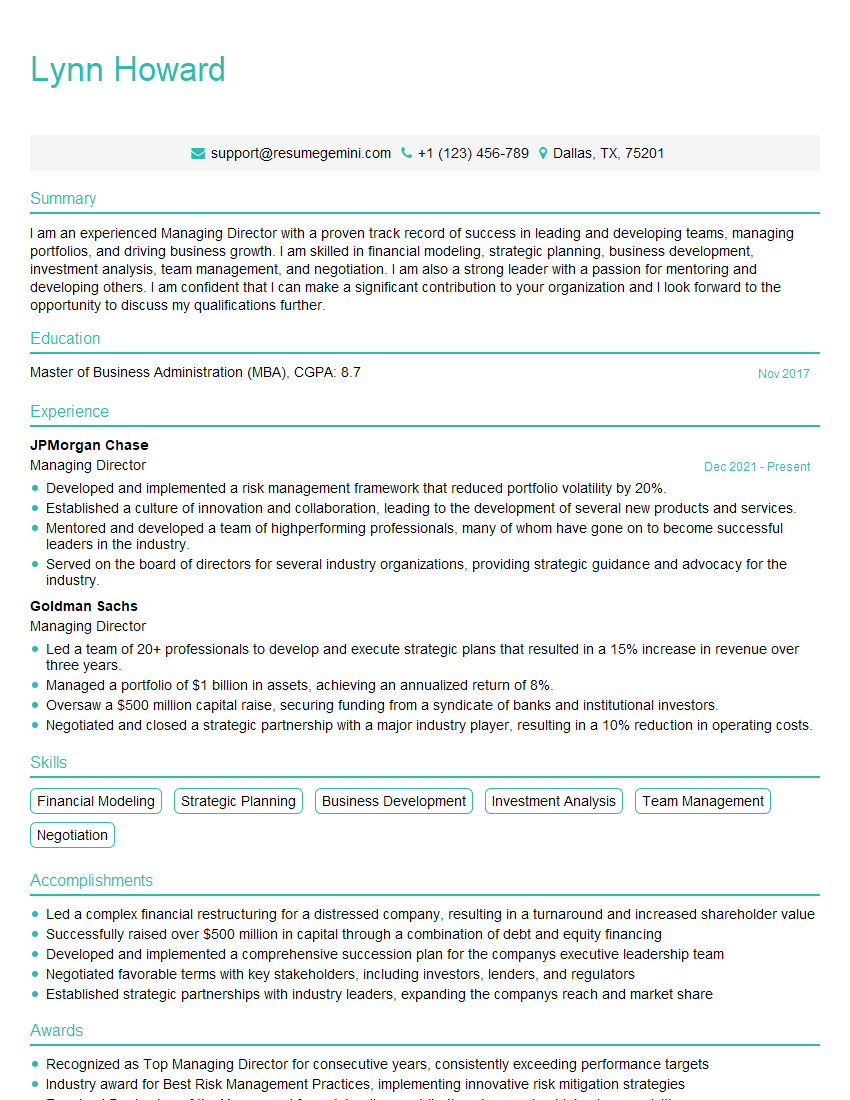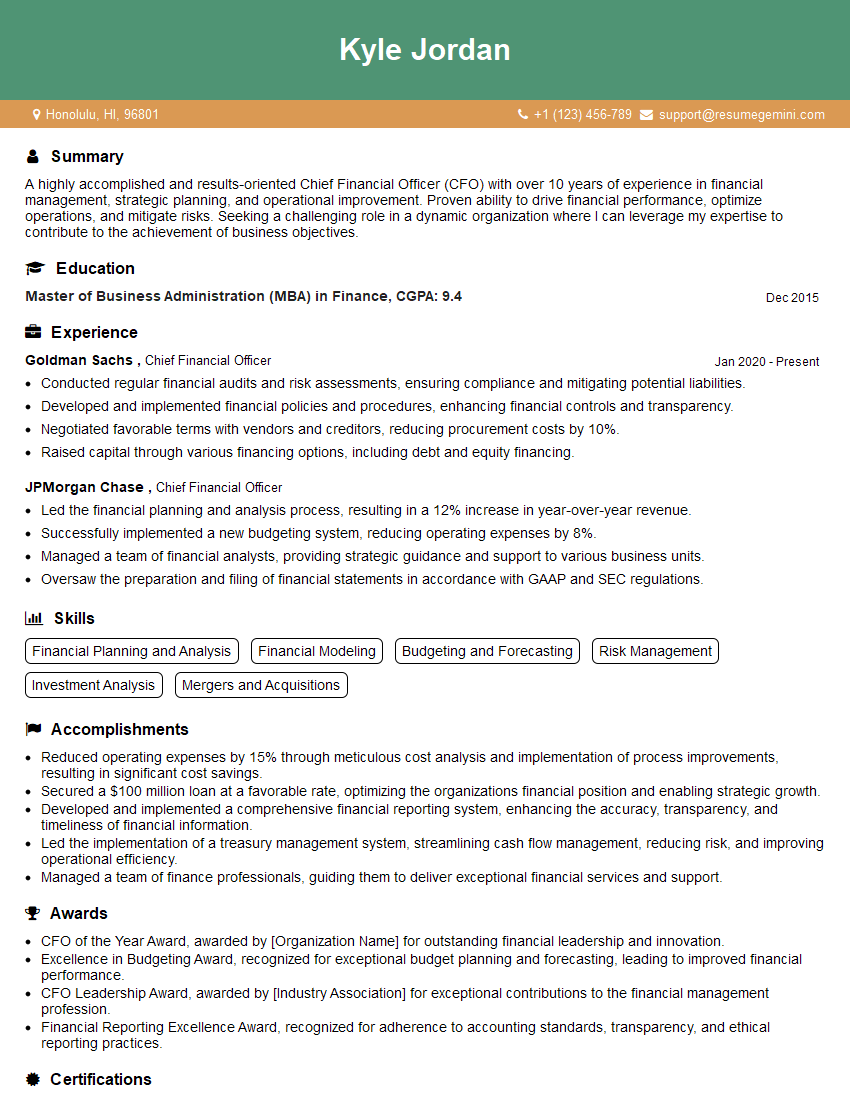Every successful interview starts with knowing what to expect. In this blog, we’ll take you through the top Command Presence interview questions, breaking them down with expert tips to help you deliver impactful answers. Step into your next interview fully prepared and ready to succeed.
Questions Asked in Command Presence Interview
Q 1. Describe a situation where you had to influence a large group without formal authority.
Influencing a large group without formal authority requires leveraging your expertise, building consensus, and demonstrating genuine care for their needs. It’s about leading through influence, not position.
For example, during a project involving cross-functional teams, I noticed a significant lack of communication hindering progress. As a senior member, but not the manager, I initiated weekly cross-team meetings. Instead of dictating solutions, I facilitated discussions, actively listening to concerns, highlighting shared goals, and encouraging collaboration. I focused on building a shared understanding of the project’s importance and our individual roles in its success. By showcasing the benefits of collaborative work, celebrating small wins, and fostering a positive team dynamic, I guided the group towards a successful outcome, overcoming initial resistance and skepticism.
Another instance involved a company-wide initiative for improved sustainability practices. Without a managerial role, I organized workshops, presentations, and created an internal communication campaign that showcased the positive impact on the environment and the company’s image. By actively engaging colleagues, answering their questions, and sharing success stories from similar initiatives, I built momentum and persuaded many to adopt sustainable practices, even without direct management oversight.
Q 2. How do you maintain composure under pressure and deliver effective communication?
Maintaining composure under pressure and delivering effective communication hinges on preparation, self-awareness, and a proactive approach. It’s about managing both your internal state and external presentation.
Firstly, thorough preparation is crucial. Knowing your subject matter deeply and anticipating potential challenges builds confidence and reduces anxiety. I find practicing my key messages and thinking through possible questions strengthens my ability to remain calm under pressure.
Secondly, self-awareness is key. Recognizing my own stress responses – whether it’s increased heart rate or a tendency to rush – helps me proactively mitigate them. Deep breathing exercises and mindfulness techniques are invaluable tools in my arsenal. I also recognize the importance of pausing before speaking, even if it’s just for a second, to gather my thoughts and articulate clearly.
Finally, focusing on the audience needs and maintaining clear, concise communication is vital. Using a calm, confident tone and actively listening to questions allows for a more productive conversation even in stressful situations. This helps to build trust and ensures the message is well received, even amidst the pressure.
Q 3. Explain how you build rapport and trust with individuals from diverse backgrounds.
Building rapport and trust with diverse individuals involves active listening, empathy, and a genuine interest in understanding different perspectives. It’s about creating a safe space for open communication and respecting individual differences.
I approach each interaction with an open mind, actively listening to understand their viewpoint rather than just waiting to respond. Asking open-ended questions, such as “Can you tell me more about that?” or “What are your thoughts on this?”, encourages individuals to share their experiences and perspectives. I pay close attention to both verbal and nonverbal cues to ensure I’m understanding the complete message being conveyed.
Empathy is vital. I try to put myself in their shoes, understanding their background and potential challenges. This means acknowledging cultural differences, communication styles, and personal experiences that might influence their views. Showing respect for their unique contributions and actively seeking their input creates a sense of value and belonging.
Finally, I build trust by being consistent in my actions and words. Being reliable, transparent, and honest fosters confidence and strengthens relationships. By acknowledging mistakes and demonstrating accountability, I demonstrate integrity, a crucial foundation for trust.
Q 4. How do you handle disagreements or conflicting perspectives within a team?
Handling disagreements and conflicting perspectives requires a collaborative approach that prioritizes finding solutions over winning arguments. It’s about facilitating constructive dialogue and reaching a common understanding.
My approach starts with actively listening to all viewpoints. I encourage individuals to express their perspectives clearly and respectfully, without interruption. I often rephrase statements to ensure everyone understands each other accurately, avoiding misunderstandings that can escalate conflict.
Once all perspectives are understood, I work towards finding common ground. This may involve identifying shared goals, compromising on minor points, or seeking creative solutions that address everyone’s concerns. I facilitate brainstorming sessions to encourage collaborative problem-solving.
If a consensus cannot be reached immediately, I suggest a structured approach, such as prioritizing concerns or developing a phased implementation plan. Documenting agreements and next steps provides transparency and accountability. This ensures that everyone is on the same page and understands their responsibilities, even if there is not complete agreement on all aspects.
Q 5. Describe a time you had to make a difficult decision with limited information.
Making difficult decisions with limited information requires a structured approach that balances risk assessment with timely action. It’s about making the best possible choice with the available data, while acknowledging the uncertainty involved.
In one instance, our team faced a critical system failure with limited information on the root cause. Instead of panicking, I implemented a structured decision-making process. First, I gathered the available data, however incomplete, prioritizing reliable sources. Second, I identified potential causes, assessing their likelihood and impact. Third, I outlined several courses of action, weighing the potential benefits and risks of each. Fourth, I consulted with colleagues, leveraging their expertise to validate my assessment and refine my options. Finally, I chose the option that mitigated the greatest risks while maximizing the chance of a quick solution, keeping in mind it was a decision based on incomplete data and open to revision as more information became available. While we didn’t have all the answers, this methodical approach enabled us to take decisive action and minimize disruption. This situation highlighted the importance of not being paralyzed by uncertainty but acting swiftly and strategically within constraints.
Q 6. How do you adapt your communication style to different audiences and situations?
Adapting communication style involves understanding your audience and tailoring your message to resonate effectively. It’s about being flexible and choosing the right approach for the situation.
My approach involves analyzing the audience’s background, knowledge level, and communication preferences. For example, a highly technical presentation to engineers would differ significantly from a presentation to senior management focused on business implications. With engineers, I’d use detailed technical explanations, charts, and data. With management, I’d focus on high-level summaries, key performance indicators, and strategic implications. I always aim to ensure the message is easily understood and relevant to their interests.
The communication channel also dictates the approach. A quick email is suitable for routine updates, while a face-to-face meeting fosters deeper engagement and collaboration for complex issues. Likewise, a formal presentation is appropriate for a large audience, while a smaller, informal discussion suits intimate settings.
Knowing when to be direct and assertive versus empathetic and collaborative is crucial. The context dictates the approach. Some situations require decisive action and firm communication, while others necessitate a more collaborative and sensitive approach.
Q 7. How do you ensure your message is clear, concise, and impactful?
Ensuring a clear, concise, and impactful message involves careful planning, structured delivery, and a focus on audience engagement. It’s about communicating effectively and efficiently.
I start by defining the key message before crafting the communication. What is the single most important thing I want the audience to understand and remember? Once this is defined, the rest of the message builds around it.
Next, I structure the information logically, using clear headings, bullet points, and visuals to aid understanding. Keeping it concise, using simple language, and avoiding jargon is vital. I also focus on storytelling, using relevant examples and analogies to make the message relatable and memorable.
Finally, I incorporate feedback mechanisms to ensure the message is received and understood correctly. This could involve asking for questions, summarizing key points, or providing additional resources. By actively engaging the audience and addressing their concerns, I ensure the message is not only clear and concise but also impactful and leaves a lasting impression.
Q 8. Describe your process for delegating tasks and managing expectations.
Delegating tasks effectively involves understanding both the task and the individual. My process begins with clearly defining the task’s objectives, scope, and expected outcomes. I then assess my team members’ skills and strengths to match the right person to the right task. This isn’t just about assigning work; it’s about empowering individuals to contribute their best.
Managing expectations is crucial. For each delegated task, I ensure there’s open communication about deadlines, deliverables, and potential roadblocks. We establish clear communication channels and set up regular check-ins to track progress and address any concerns. For example, if I delegate a complex coding project, I’ll schedule daily stand-ups to keep abreast of progress, address any technical challenges, and ensure alignment with project goals. This proactive communication prevents misunderstandings and ensures everyone is on the same page.
Think of it like building a bridge. The task is the destination, the team members are the builders, and clear communication forms the foundation ensuring a solid and successful outcome.
Q 9. How do you handle constructive criticism and use it to improve your performance?
Constructive criticism is a gift; it’s an opportunity to grow and improve. I embrace feedback, regardless of its source, viewing it as an essential component of professional development. My process involves actively listening to the feedback, asking clarifying questions to fully understand the points raised, and reflecting on how I can improve.
I don’t get defensive; instead, I focus on the specific points of improvement suggested. If the criticism is valid, I create a plan to address it, setting realistic goals and timelines for improvement. I document the feedback and track my progress. For instance, if a peer suggests improving my presentation skills, I might enroll in a public speaking course or practice my presentations more frequently and seek feedback from trusted colleagues.
The key is to transform criticism from a judgment into a tool for self-improvement. It’s about continuous learning and evolution.
Q 10. Explain your approach to providing feedback to team members.
Providing feedback is a crucial aspect of leadership and team development. My approach is centered around clarity, specificity, and constructive dialogue. I prefer to give feedback in a timely manner, ensuring the issues are fresh in everyone’s minds. I favor the ‘sandwich method’: starting with a positive comment, highlighting areas needing improvement with specific examples, and concluding with another positive note and an encouragement for growth. For example, if I’m giving feedback on a written report, I might start by praising the clarity of the introduction, then suggest improvements on data visualization and referencing, and finally, praise their comprehensive conclusions.
I focus on behavior, not personality. Instead of saying “You’re disorganized,” I’d say “The project timeline could be improved by better prioritizing tasks.” I encourage a two-way conversation; I want to understand their perspective and ensure they understand my feedback. This collaborative approach fosters a culture of open communication and growth.
Q 11. How do you prioritize tasks and manage competing deadlines?
Prioritizing tasks and managing competing deadlines requires a structured approach. I utilize a combination of techniques including the Eisenhower Matrix (urgent/important), prioritizing based on project dependencies, and using project management tools. The Eisenhower Matrix helps categorize tasks based on urgency and importance, enabling me to focus on high-impact activities first.
Understanding project dependencies is vital. Certain tasks must be completed before others can begin. I build a project timeline outlining task dependencies and critical paths to identify potential bottlenecks. I use project management software like Jira or Asana to track tasks, deadlines, and progress, allowing for real-time adjustments based on changing priorities. If unexpected delays occur, I communicate proactively with stakeholders and adjust the project timeline accordingly, ensuring transparency and maintaining expectations.
Q 12. How do you proactively identify and address potential challenges?
Proactive challenge identification is crucial for successful project delivery. I employ a risk assessment process, regularly reviewing project plans and identifying potential obstacles. This involves considering factors such as resource constraints, technical challenges, and potential external factors. For instance, if a project relies on a third-party vendor, I’d proactively assess the vendor’s reliability and plan for potential delays.
Once potential challenges are identified, I develop mitigation strategies. This might involve allocating buffer time for unexpected issues, identifying alternative solutions, or establishing contingency plans. Open communication with the team is key—discussing potential issues proactively builds team resilience and promotes collective problem-solving. Think of it like a ship’s captain anticipating storms—being prepared is half the battle.
Q 13. Describe a time you had to negotiate a complex agreement.
In a previous role, I had to negotiate a complex agreement with a vendor regarding a critical software implementation. The initial contract terms were unfavorable to our company. My approach involved thorough research and preparation, understanding our needs and the vendor’s capabilities and limitations.
I started the negotiation by building rapport, establishing common ground, and clearly stating our requirements. We used a collaborative approach, focusing on finding a mutually beneficial agreement, rather than an adversarial one. I identified areas where we could compromise, offering concessions in areas less critical to us in exchange for favorable terms elsewhere. Active listening and clear communication throughout the process were essential. Ultimately, we reached an agreement that benefited both parties, demonstrating my ability to navigate complex negotiations effectively.
Q 14. How do you motivate and inspire your team to achieve common goals?
Motivating and inspiring a team requires a combination of strategies. I believe in fostering a positive and collaborative work environment where every team member feels valued and respected. I start by setting clear, shared goals, ensuring everyone understands their role and how it contributes to the overall objective. This provides a sense of purpose and encourages teamwork.
Regular recognition and appreciation are essential. I actively acknowledge individual and team accomplishments, celebrating successes, and highlighting individual contributions. I also encourage open communication, providing opportunities for team members to share their ideas and concerns. This can be facilitated through team meetings, informal discussions, and collaborative project planning sessions. Ultimately, leading by example, demonstrating commitment and passion for the shared goals, inspires a team to achieve great things.
Q 15. How do you stay calm and collected in stressful situations?
Maintaining composure under pressure is crucial in command presence. My approach is multifaceted. Firstly, I prioritize proactive preparation. Thorough planning and anticipating potential challenges significantly reduces stress. Secondly, I employ mindfulness techniques. Taking deep breaths, focusing on the present moment, and detaching from overwhelming emotions helps me regain clarity. Thirdly, I rely on structured problem-solving. Breaking down complex issues into smaller, manageable steps allows for a more methodical and less stressful approach. For example, during a critical system failure, instead of panicking, I’d systematically follow our established protocols: assess the situation, identify the problem, implement the appropriate solution, and then communicate the updates transparently. This systematic approach keeps me focused and prevents impulsive reactions.
Career Expert Tips:
- Ace those interviews! Prepare effectively by reviewing the Top 50 Most Common Interview Questions on ResumeGemini.
- Navigate your job search with confidence! Explore a wide range of Career Tips on ResumeGemini. Learn about common challenges and recommendations to overcome them.
- Craft the perfect resume! Master the Art of Resume Writing with ResumeGemini’s guide. Showcase your unique qualifications and achievements effectively.
- Don’t miss out on holiday savings! Build your dream resume with ResumeGemini’s ATS optimized templates.
Q 16. How do you handle interruptions and stay focused on your tasks?
Interruptions are inevitable, especially in demanding leadership roles. My strategy involves a combination of proactive and reactive measures. Proactively, I establish clear communication boundaries. I inform my team of my focused work periods and encourage scheduling meetings or discussions during designated times. Reactively, I utilize effective interruption management techniques. If interrupted during a critical task, I politely acknowledge the interruption, briefly note the issue, and then return to my primary focus. This approach necessitates prioritization and disciplined time management. For instance, if a less urgent email arrives during a crucial meeting preparation, I’ll flag it for later review instead of immediately diverting my attention.
Q 17. Describe your experience leading a project from initiation to completion.
In my previous role, I led the implementation of a new cybersecurity protocol across our entire organization. This project involved several phases. The initiation stage included defining project goals, assembling a cross-functional team, and establishing clear timelines and deliverables. The execution phase involved regular team meetings, task delegation, and continuous monitoring of progress. We faced challenges, such as resistance to change from some departments, which we addressed through proactive communication and training. The completion phase involved a thorough system audit to verify the effectiveness of the new protocol and documenting the entire process for future reference. The successful implementation resulted in a significant reduction in security breaches and improved overall system security.
Q 18. How do you measure your own success and the success of your team?
Success measurement is multifaceted. For myself, it’s about consistent improvement and the achievement of clearly defined objectives. I track my progress against key performance indicators (KPIs) and regularly self-assess my performance, identifying areas for growth. For my team, success is measured by the collective achievement of our shared goals, the individual growth of team members, and the overall team morale and efficiency. We use a balanced scorecard approach, considering qualitative factors like team cohesion and innovation alongside quantitative metrics like project completion rates and customer satisfaction. For instance, a successful project isn’t just about meeting deadlines; it’s also about fostering a collaborative environment and developing the skills of each team member.
Q 19. How do you build and maintain strong professional relationships?
Building and maintaining strong professional relationships relies on mutual respect, open communication, and trust. I prioritize active listening and empathetic understanding. I make a conscious effort to connect with colleagues on a personal level, understanding their motivations and perspectives. I also proactively seek feedback and actively participate in team-building activities. For example, I regularly check in with team members, not just about work progress, but also about their well-being and challenges. Transparency and honesty are paramount – addressing concerns directly and fostering a safe environment where individuals feel comfortable expressing their thoughts and opinions.
Q 20. Explain how you use data and analytics to inform your decision-making.
Data and analytics are essential for informed decision-making. I utilize data visualization tools and statistical analysis to identify trends, patterns, and potential risks. For example, when evaluating the success of a marketing campaign, I wouldn’t solely rely on anecdotal evidence. Instead, I’d analyze key metrics such as website traffic, conversion rates, and customer acquisition costs. This data-driven approach ensures that decisions are based on factual information rather than intuition or assumptions. Example: A/B testing different website designs to determine which version drives higher conversion rates.
Q 21. How do you manage your time effectively and prioritize your workload?
Effective time management is crucial for maintaining command presence. My approach combines planning, prioritization, and execution. I begin each day by reviewing my schedule and prioritizing tasks based on urgency and importance using methods like the Eisenhower Matrix (Urgent/Important). I break down large tasks into smaller, more manageable steps and allocate specific time blocks for focused work. I utilize time management tools like project management software to track progress and ensure accountability. I also actively avoid multitasking, focusing on one task at a time to maximize efficiency and minimize errors. Regular breaks are essential to maintain focus and prevent burnout.
Q 22. Describe a situation where you had to make a quick decision that had significant consequences.
During a critical incident response exercise simulating a major cyberattack, we faced a cascading failure across multiple systems. We had only minutes to decide whether to initiate a full system shutdown, potentially causing significant data loss but preventing further compromise, or attempt a targeted containment strategy, risking broader damage. After quickly assessing the situation with my team, weighing the risks and potential consequences, I made the call to initiate a phased shutdown, prioritizing the most critical systems first. This decision, while difficult, proved successful in minimizing the overall damage. We lost some data, but prevented a far more catastrophic complete system failure. This situation highlighted the importance of rapid risk assessment and decisive action under pressure.
Q 23. How do you deal with difficult or challenging individuals?
Dealing with difficult individuals requires a multifaceted approach built on empathy, clear communication, and a focus on shared goals. I start by actively listening to their concerns and perspectives, even if I don’t agree with them. I then focus on finding common ground and reframing the situation to highlight shared objectives. For instance, I might say, “I understand your frustration about the project timeline. Let’s work together to find solutions that meet both our needs and still allow us to deliver a high-quality product.”
If direct communication isn’t effective, I might involve a neutral third party to mediate. The key is to maintain professionalism and respect, even when faced with hostility or resistance. My ultimate goal is to create a collaborative environment where everyone feels heard and valued, even those who initially presented challenges.
Q 24. How do you use your communication skills to build consensus and achieve buy-in?
Building consensus and achieving buy-in requires more than simply presenting information; it demands fostering collaboration and creating a sense of shared ownership. I employ a combination of techniques, starting with transparent and open communication. This includes clearly defining the problem, presenting the relevant data, and outlining the proposed solution. Next, I actively solicit feedback and encourage open dialogue, making sure all stakeholders have a voice. I strive to address their concerns and incorporate their insights into the final plan. This collaborative approach transforms individuals from mere recipients of information into active participants, fostering a stronger sense of investment in the project’s success.
For example, when implementing a new security protocol, I wouldn’t simply dictate its implementation. I’d hold workshops, demonstrate its benefits, and address any concerns about its impact on workflow. This approach ensured everyone understood and supported the changes, leading to smoother implementation and greater overall effectiveness.
Q 25. How do you navigate ambiguity and uncertainty?
Navigating ambiguity and uncertainty requires a structured approach. I begin by clearly defining what is known and what is unknown. I then break down the problem into smaller, more manageable parts. This allows for a more focused analysis of individual aspects of the situation, even in the absence of complete information. Next, I explore various potential scenarios and develop contingency plans for each. This proactive approach to risk management mitigates the negative impact of unforeseen circumstances. Finally, I maintain open communication, updating stakeholders regularly and adjusting course as new information becomes available. Flexibility and adaptability are critical in this environment. Essentially, I embrace the uncertainty and focus on building a robust plan that can adjust with evolving information.
Q 26. Explain how you handle public speaking or presentations.
Public speaking and presentations are integral to my role. My approach involves careful planning and practice. I begin by thoroughly researching the topic and tailoring my presentation to the audience. I use clear, concise language, avoiding jargon unless absolutely necessary, and use visual aids to enhance understanding. I practice the presentation multiple times, refining the delivery and timing. During the actual presentation, I maintain strong eye contact with the audience, encouraging engagement. I also handle questions confidently and directly, ensuring all queries are addressed thoroughly. This structured approach reduces anxiety and allows me to confidently and effectively communicate my message to a large audience.
Q 27. Describe your experience with conflict resolution.
Conflict resolution is a key skill in my profession. My approach is centered on creating a safe space for open communication. I begin by actively listening to all parties involved, ensuring each person feels heard and understood. Then, I help them identify the root cause of the conflict, focusing on the issue rather than personalities. Next, I guide them towards collaboratively developing solutions that address the needs of all parties. I always aim for a mutually acceptable outcome, even if it means compromise from all sides. Finally, I ensure a clear understanding of the agreed-upon solution and follow up to ensure its successful implementation and prevent future conflicts. I view conflict as an opportunity for growth and stronger working relationships.
Q 28. How do you demonstrate accountability for your actions and decisions?
Demonstrating accountability involves taking ownership of both successes and failures. I always take responsibility for my actions and decisions, acknowledging both positive and negative outcomes. If mistakes are made, I openly admit them, analyze the root cause, and actively work to correct the situation and prevent recurrence. For example, if a project misses a deadline, I take responsibility and explain the reasons for the delay, outlining the corrective actions we implemented. I provide transparent progress updates to stakeholders and ensure appropriate follow-up actions. This transparency builds trust and demonstrates my commitment to excellence and responsibility.
Key Topics to Learn for Command Presence Interview
- Understanding Nonverbal Communication: Learn to decipher and project confident body language, including posture, eye contact, and hand gestures. Consider how these elements contribute to conveying authority and trustworthiness.
- Vocal Delivery and Tone: Practice articulate speech, modulate your tone to maintain engagement, and project your voice effectively. Think about how variations in vocal delivery can impact the message and the audience’s perception.
- Strategic Communication: Develop skills in concise and impactful communication. Practice structuring your thoughts clearly and delivering them with conviction. Consider how to tailor your message to different audiences and situations.
- Active Listening and Engagement: Master the art of actively listening to understand the nuances of conversation, respond thoughtfully, and build rapport. Explore techniques for demonstrating engagement and understanding through both verbal and nonverbal cues.
- Confidence and Assertiveness: Cultivate a strong sense of self-assurance and the ability to express your opinions and ideas confidently, without being aggressive. Reflect on situations where you’ve demonstrated these qualities and how you can highlight them during the interview.
- Handling Difficult Questions and Objections: Develop strategies for responding to challenging interview questions calmly and professionally, demonstrating composure and problem-solving skills under pressure. Practice formulating thoughtful and insightful responses.
Next Steps
Mastering command presence is crucial for career advancement. It opens doors to leadership roles, enhances your influence, and strengthens your overall professional brand. To maximize your job prospects, building an ATS-friendly resume is essential. This ensures your qualifications are effectively communicated to hiring managers. We highly recommend using ResumeGemini to craft a professional and impactful resume. ResumeGemini provides tools and resources to help you create a resume that showcases your command presence and highlights your skills effectively. Examples of resumes tailored to emphasize Command Presence are available below to help guide your efforts.
Explore more articles
Users Rating of Our Blogs
Share Your Experience
We value your feedback! Please rate our content and share your thoughts (optional).
What Readers Say About Our Blog
Hi, I represent an SEO company that specialises in getting you AI citations and higher rankings on Google. I’d like to offer you a 100% free SEO audit for your website. Would you be interested?
good
